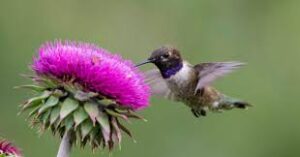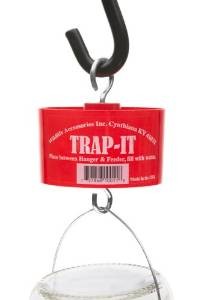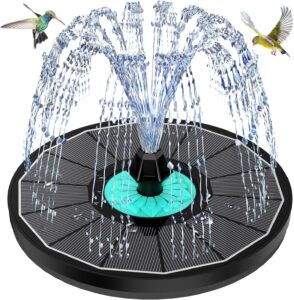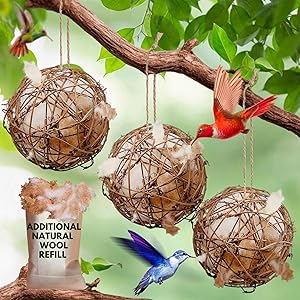add 1 part sugar to 4 parts water, boil 2 minutes, let cool
Here you will learn how to make hummingbird nectar, when to change the nectar in your feeder, the proper way to clean your feeder, how to keep ants and bees out of your feeder and so much more.
Hummingbird Food Recipe: A Simple Guide to Feeding Your Feathered Friends
Did you know that hummingbirds have the highest metabolism of any animal on Earth? These tiny marvels can beat their wings up to 80 times per second and visit up to 2,000 flowers in a single day. With such high energy demands, it’s no wonder they need to eat frequently. That’s where you come in! By providing a safe and nutritious food source, you can help these enchanting creatures thrive in your backyard. In this comprehensive guide, we’ll cover everything you need to know about making the perfect hummingbird food recipe, from the ingredients to feeder maintenance.
What You’ll Need
Before we dive into the recipe, let’s gather all the necessary ingredients and tools. Fortunately, making hummingbird food is a simple process 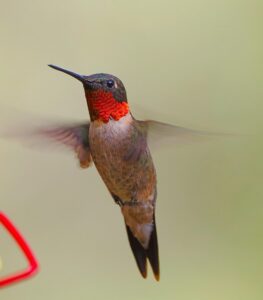 that requires only a few common household items.
that requires only a few common household items.
Ingredients:
-
White granulated sugar
-
Water (preferably filtered or spring water)
Tools:
-
Measuring cup
-
Saucepan
-
Spoon for stirring
-
Clean bottle or container for storage
-
Hummingbird feeder
It’s important to note that you don’t need any special ingredients or additives. In fact, keeping it simple is the best way to ensure the health and safety of your feathered visitors.
How to Make Hummingbird Food
Now that we have everything ready, let’s get started with the step-by-step process of making hummingbird food. This recipe is quick, easy, and perfectly tailored to meet the nutritional needs of hummingbirds.
Step 1: Measure the Ingredients
The key to a perfect hummingbird nectar is getting the right sugar-to-water ratio. The ideal proportion is:
-
4 parts water
-
1 part white granulated sugar
For example, you could use 1 cup of sugar for every 4 cups of water. This ratio closely mimics the natural nectar found in flowers that hummingbirds typically feed on.
Use Songbird Essentials Nectar Aid Self Measuring Pitcher and never measure ingredients again. Make any amount and the ingredients are measured for you.
 |
Step 2: Heat the Water
Next, pour the measured water into a saucepan and heat it on the stove while bringing the water to a boil. The importance of boiling the water is to remove chlorine from the water and to kill any mold spores or any yeast spores that might be in the granulated sugar.
Continue boiling the nectar for two minutes and then take it off the heat to cool. You don’t need to boil the nectar any longer than 2 minutes or you will boil away enough of the water to change the ratio of sugar to water. A higher sugar concentration resulting from boiling too long, will be more likely to attract insects such as bees and wasps.
Step 3: Add and Dissolve the Sugar
Once the water is warm, add the measured sugar to the saucepan. Stir the mixture gently until all the sugar has completely dissolved. This usually takes about 1-2 minutes. Make sure there are no sugar granules left at the bottom of the pan.
Step 4: Let the Mixture Cool
After the sugar has dissolved, remove the saucepan from the heat and let the mixture cool to room temperature. Never fill your feeder with hot nectar, as it could potentially harm the hummingbirds or cause the feeder to crack.
Step 5: Fill Your Feeder
Once the nectar has cooled, it’s ready to use. Fill your clean hummingbird feeder with the fresh nectar. If you have any leftover nectar, you can store it in a clean, sealed container in the refrigerator for up to a week.
Making hummingbird nectar instructional video
Important Tips:
-
Do not add red food coloring or any other additives to the nectar. These can be harmful to hummingbirds. The only purpose of the food coloring is to attract hummingbirds and the red on your feeder will be enough to do that. Red food coloring is also thought to be harmful to the Hummingbirds, so not using it at all will be the safe way to go.
-
Use only white granulated sugar. Brown sugar, honey, artificial sweeteners, or sugar substitutes can be dangerous for hummingbirds.
-
Always use clean tools and containers to prevent the growth of harmful bacteria or mold.
By following these simple steps, you’ll create a safe and nutritious food source that will keep hummingbirds coming back to your yard time and time again.
Tips for Maintaining Your Hummingbird Feeder
Creating the perfect nectar is only half the battle. To ensure the health and safety of your hummingbird visitors, proper feeder maintenance is crucial. Let’s explore some essential tips for keeping your feeder clean and your nectar fresh.
Cleaning Your Feeder
Regular cleaning is vital to prevent the growth of mold and bacteria, which can be harmful to hummingbirds. Here’s a simple cleaning routine 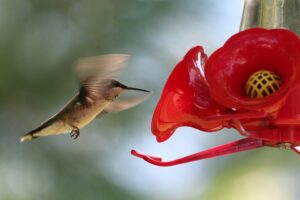 you can follow:
you can follow:
-
Empty the feeder completely.
-
Rinse it thoroughly with hot water.
-
Use a mild soap solution and a bottle brush to scrub all parts of the feeder, especially around feeding ports and crevices.
-
Rinse again with hot water to remove all soap residue.
-
For a deep clean, you can use a solution of 1 part white vinegar to 4 parts water. Soak the feeder in this solution for about an hour, then rinse thoroughly.
-
Allow the feeder to air dry completely before refilling.
Aim to clean your feeder at least once a week, or more frequently in hot weather. If you notice any signs of mold or cloudy nectar, clean the feeder immediately.
Here’s a comprehensive guide to help you clean your hummingbird feeder for those times when the nectar is not changed soon enough and mold starts to grow.
Here is a good video on how to clean a hummingbird feeder
When to Refill or Replace Nectar
The frequency of nectar replacement depends largely on the weather and how quickly the hummingbirds consume it. Here are some general guidelines:
-
In hot weather (80°F or above): Replace every 2-3 days
-
In mild weather (70-80°F): Replace every 3-4 days
-
In cool weather (below 70°F): Replace every 5-7 days
However, if you notice any of the following signs, replace the nectar immediately:
-
Cloudy or milky appearance
-
Stringy or moldy patches
-
Black or white spots in the liquid
-
Buildup around feeder ports
Remember, it’s always better to err on the side of caution. If in doubt, replace the nectar. Fresh, clean nectar is essential for the health of your hummingbird visitors.
Guide for when to change the nectar
Letting the nectar ferment encourages mold growth, which makes the cleaning process more difficult. To avoid this, follow the chart below for recommended nectar changes based on the temperature. The hotter it gets, the more frequently you’ll need to replace the nectar.
High temperatures…………Change after
71-75……………………………6 days
76-80……………………………5 days
81-84……………………………4 days
85-88……………………………3 days
89-92……………………………2 days
93+………………………………change daily
Placement of Your Feeder
Where you place your feeder can significantly impact how often hummingbirds visit. Consider these tips:
-
Hang feeders in a shaded area to slow fermentation of the nectar.
-
Place feeders near flowering plants that naturally attract hummingbirds.
-
Ensure feeders are visible from multiple angles.
-
Keep feeders away from windows to prevent bird collisions.
-
If you have multiple feeders, space them out to reduce territorial behavior among hummingbirds.
By following these maintenance tips, you’ll create a safe and inviting environment for hummingbirds to feed and thrive in your yard.
Here’s a great article that tells everything you need to know about how to choose the best place to hang your hummingbird feeder.
Frequently Asked Questions
As you embark on your hummingbird feeding journey, you might encounter some common questions or concerns. Let’s address some of these frequently asked questions to help you become a hummingbird feeding expert.
How often should I change the nectar?
The frequency of nectar changes depends on the weather. In hot weather (80°F or above), change the nectar every 2-3 days. In mild weather (70-80°F), every 3-4 days is sufficient. During cooler periods (below 70°F), you can extend this to every 5-7 days. However, always replace the nectar if it appears cloudy, discolored, or shows any signs of mold growth.
Can I use honey or artificial sweeteners instead of sugar?
No, it’s crucial to stick with plain white granulated sugar. Honey can promote dangerous fungal growth in hummingbirds’ tongues and beaks. Artificial sweeteners, on the other hand, provide no nutritional value and may even be harmful to these tiny birds. The simple sugar-water solution best mimics the natural nectar hummingbirds get from flowers.
Do I need to add red food coloring to attract hummingbirds?
Absolutely not! Red food coloring is unnecessary and potentially harmful to hummingbirds. Most hummingbird feeders are designed with red parts to attract the birds naturally. If you want to make your feeder more attractive, you can tie a red ribbon around it or plant red flowers nearby instead.
What should I do if ants are getting into my hummingbird feeder?
Ants can be a nuisance, but there are several ways to deter them:
-
Use an ant moat: This is a small cup of water that hangs above the feeder, creating a barrier ants can’t cross.
- If you already have a hummingbird feeder, and you want to protect it from ants and other crawling insects, the ant moat below will do the job.Trap-It Ant Moat for Hummingbird FeedersUsing an ant moat for your hummingbird feeder is an effective way to keep ants away from the sweet nectar. These tiny creatures are drawn to

ant moat the sugar water, and without a barrier, they will quickly infest your feeder, preventing the birds from enjoying the nectar. An ant moat works by creating a barrier of water that ants can’t cross. Positioned above the feeder, it effectively blocks the ants’ path, keeping them from reaching the nectar.
This simple solution also ensures that your hummingbird feeder remains clean and accessible for the birds, rather than becoming a breeding ground for ants or other pests. It’s a small addition that can make a big difference in maintaining a healthy, inviting space for hummingbirds, while also reducing the need for chemical ant deterrents.
The first and still the best toprotect your Hummingbird and Oriole feeder from antsand other crawling insects. Insert between hanger and feeder and fill with water, providing a barrier to crawling pests. Red color to attract hummingbirds.
Ant Moats are a simple and inexpensive way to keep ants out of your hummingbird feeders while also providing water to other wildlife in your yard.
-
Apply a thin layer of petroleum jelly around the hanger: This creates a slippery surface ants can’t navigate.
-
Move the feeder: Sometimes, relocating the feeder can throw ants off the trail.
Remember, never use pesticides near your hummingbird feeder, as these can be harmful to the birds.
Nectar Fortress™ Natural Ant Repellent; Multi-Purpose Clear Gel Ant Guard for Hummingbird Feeders

If bees become a problem, here’s how to outsmart Bees and Safeguard Your Hummingbird Feeder
Bee-Proof Hummingbird Feeders – Here is Your Answer – A Quick and Easy Way to Keep Bees Away
hummingbird feeder bee guards
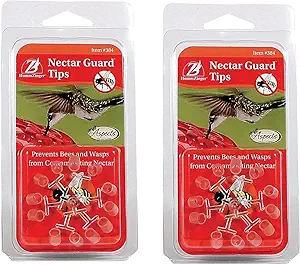
Below is a video that will show you how to keep bees out of your feeder using plastic mesh from an onion sack.
A good hummingbird feeder will solve your bee and ant problems and a whole lot more! This is the ultimate way to get rid of ants and bees!
So what makes a good feeder, good? There are a few features that separate a great feeder from all the rest.
*First off, a great feeder will always be a non-leaking feeder. A feeder that leaks will attract all kinds of unwanted visitors as the nectar leaks onto the outside of the feeder and then onto the ground.
There are 2 basic kinds of hummingbird feeders, a basin /saucer feeder and inverted bottle feeders. The saucer feeders are like a little dish with a cover on top. The cover has the feeding ports where the hummingbirds feed. The bottle feeders, that have a bottle that screws into the base of the feeder.
A great feeder will be red, to attract hummingbirds will leak. As the nectar level in the bottle goes down, it leaves an air pocket behind at the top of the feeder. Heat will cause the air to expand and that will push nectar out of the feeding ports around the bottom of the feeder. In a basin feeder, the nectar is always below the feeding ports and can never be forced out of the ports.
*A great feeder will be red, to attract hummingbirds. Hummingbirds are most attracted to the color red.
*A great feeder will have an ant moat built into the design of the feeder or will have an add on moat. These will keep ants out of the hummingbird nectar.
*A great feeder will have some sort of protection to keep out bees. The yellow bee guards found on most feeders will attract bees and wasps. They like the color yellow. A great feeder has bee protection built into the feeder in the form of “Nectar Guard Tips”. These are flexible plastic membranes that fit onto the underside of the feeding ports. The hummingbird’s long beak can reach down right through them. When the beak is pulled out the guard tips close the hole up and keep out the bees.
*A great feeder will have perches for the hummingbirds to sit on while they feed. This allows the birds to conserve energy and allows you to get a good view of them while they are sitting still.
*A great feeder will have rain guards to keep rain water from running into the feeder ports and diluting the nectar. These are raised and usually flower shaped and encircle the holes in the feeder. They will be red, so they don’t attract bees and wasps.
*And very important, a great feeder will be easy to take apart and clean. Clean nectar and a clean feeder are the keystone to your hummingbird feeding success. If the feeder design makes it easy for you to clean the feeder, you are a lot more likely to keep it clean.
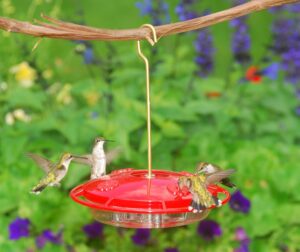
WOW! ………. that seems like so much to ask for, and it is! That’s why so many hummingbird feeders will fall short of the mark.
The good news is, there are feeders that have all these great feeder designs that will make your life easy.
My favorite hummingbird feeder to use with the hummingbird food recipe is the HummZinger Ultra. It’s a great feeder that will solve all your pest problems and has all the great features listed above.
How can I attract more hummingbirds to my yard?
While a well-maintained feeder is a great start, there are several other ways to make your yard more hummingbird-friendly:
-
Plant native, nectar-rich flowers: Trumpet honeysuckle, cardinal flower, and bee balm are great choices.
-
Provide a water source: Hummingbirds love moving water. A small fountain or mister can be very attractive to them.
-
Consider adding a mister or dripper to create moving water, which attracts hummingbirds. They often enjoy flying through fine sprays of water.

-
Offer perches: Small twigs or thin branches near your feeder give hummingbirds a place to rest.
- A hummingbird perch is a good way to attract hummingbirds to a particular spot near your feeder

Did you know that hummingbirds spend most of their time perched? This video will tell you how to get them to perch close to your feeders where you can see them! Using this method I guarantee that you will attract more hummingbirds to your feeders.
-
Avoid pesticides: These can harm hummingbirds and reduce their insect food sources.
-
Provide nesting materials like cotton, pet fur, or plant fibers. You can place these materials in suet cages or spread them around your garden.

hummingbird nesting material -
Maintain consistency: Once you start feeding, try to maintain a reliable food source throughout the season.
Here’s a complete guide to attracting hummingbirds to your yard. It lists plants, vines and shrubs that are in bloom for spring, summer and fall. Your hummingbirds will always have flowers to feed on.
Is it okay to feed hummingbirds year-round?
This depends on your location. In areas where hummingbirds are present year-round, it’s perfectly fine to keep feeders up all year. However, in regions where hummingbirds migrate, it’s best to put feeders up about a week before their expected arrival in spring and take them down about a week after you’ve seen the last hummingbird in fall. Keeping feeders up too late in the season won’t prevent hummingbirds from migrating, but it’s generally not necessary.
How many hummingbird feeders should I have?
The number of feeders you should have depends on how many hummingbirds visit your yard and how territorial they are. Start with one or two feeders and observe. If you notice a lot of competition or aggressive behavior, consider adding more feeders spaced around your yard. This can help reduce territorial disputes and allow more hummingbirds to feed peacefully.
What time of day are hummingbirds most active at feeders?
Hummingbirds are typically most active during the early morning and late afternoon hours. However, they may visit feeders throughout the day, especially during breeding season when their energy demands are highest. Keeping your feeders full and clean ensures that nectar is available whenever the hummingbirds need it.
By understanding these common questions and concerns, you’ll be well-equipped to provide the best care for your hummingbird visitors. Remember, observing and learning from these fascinating creatures is part of the joy of feeding them!
The Importance of Natural Food Sources
While providing nectar feeders is a great way to attract and support hummingbirds, it’s important to remember that these feeders should supplement, not replace, natural food sources. Hummingbirds have a diverse diet that includes more than just nectar.
Insects: A Crucial Part of Hummingbird Diet
Surprisingly to many, insects make up a significant portion of a hummingbird’s diet. They provide essential proteins and fats that nectar alone cannot supply. Hummingbirds consume a variety of small insects and spiders, including:
-
Gnats
-
Fruit flies
-
Aphids
-
Mosquitoes
-
Small spiders
To support this aspect of their diet, consider maintaining a pesticide-free garden that attracts these small insects naturally.
Native Plants: The Best Hummingbird Feeders
While artificial feeders are helpful, especially during times when natural nectar is scarce, native plants are the best source of nutrition for hummingbirds. They provide not only nectar but also attract the insects that hummingbirds need. Some excellent native plants for hummingbirds include:
-
Trumpet Honeysuckle (Lonicera sempervirens)
-
Cardinal Flower (Lobelia cardinalis)
-
Bee Balm (Monarda didyma)
-
Columbine (Aquilegia canadensis)
-
Coral Bells (Heuchera sanguinea)
By incorporating these plants into your garden, you create a more natural and complete feeding environment for hummingbirds.
Here’s a comprehensive guide that shows you how to attracting hummingbirds to your yard. It lists plants, vines and shrubs that are in bloom for spring, summer and fall. Your hummingbirds will always have flowers to feed on.
Seasonal Considerations for Feeding Hummingbirds
Feeding hummingbirds isn’t a one-size-fits-all activity throughout the year. As seasons change, so do the needs and behaviors of these tiny birds. Let’s explore some seasonal considerations to keep in mind.
Hummingbird migration is a long distance journey that happens twice a year, and it is not easy. For hummingbirds, migration is an intense activity full of a lot of danger, especially when some cross the Gulf of Mexico. This video discusses 12 ways we can help North American Hummingbirds survive migration including keeping garage doors shut, keeping nectar feeders clean, turning your backyard into a stopover site, and so so much more.
Spring: Welcoming Returning Migrants
In many parts of North America, spring marks the return of migratory hummingbirds. To prepare for their arrival:
-
Put your feeders out about a week before the expected return date in your area.
-
Ensure your yard has early-blooming flowers to provide natural nectar sources.
-
Keep your nectar mixture slightly more concentrated (3 parts water to 1 part sugar) to help birds recover from their long journey.
Summer: Peak Feeding Season
Summer is when hummingbird activity is at its highest. During this time:
-
Check and refill feeders more frequently, as consumption will increase.
-
Clean feeders more often due to faster fermentation in hot weather.
-
Provide multiple feeding stations to accommodate more birds and reduce competition.
Fall: Preparing for Migration
As fall approaches, hummingbirds need to prepare for migration by building up fat reserves. To help them:
-
Keep feeders up until at least two weeks after you’ve seen the last hummingbird.
-
Maintain a consistent food supply, as birds may rely more heavily on feeders as natural sources diminish.
-
Consider planting late-blooming flowers to provide natural nectar into the fall.
Winter: Supporting Year-Round Residents
In some regions, certain hummingbird species don’t migrate. If you live in such an area:
-
Continue to maintain clean feeders with fresh nectar throughout the winter.
-
Consider using a feeder heater in freezing temperatures to prevent the nectar from freezing.
-
Plant evergreen plants that provide shelter and, in some cases, winter blooms.
By adjusting your feeding practices with the seasons, you can provide optimal support for hummingbirds throughout the year.
Conclusion
Feeding hummingbirds can be an incredibly rewarding experience. These tiny, vibrant creatures bring joy and wonder to any garden or backyard. By following this guide, you’re now equipped with the knowledge to create the perfect hummingbird food recipe, maintain clean feeders, and support these amazing birds throughout the seasons.
Remember, the key points to successful hummingbird feeding are:
-
Use the correct sugar-to-water ratio (4:1) without any additives.
-
Keep feeders clean and replace nectar regularly.
-
Supplement feeders with natural food sources, including native plants and insect-friendly gardens.
-
Adjust your feeding practices with the changing seasons.
We encourage you to start your hummingbird feeding journey today. Prepare your first batch of nectar, set up a clean feeder, and watch as these fascinating birds discover their new food source. Don’t forget to observe and learn from their behaviors – each hummingbird visit is a unique opportunity to connect with nature.
Share your experiences with friends and family, and consider keeping a journal of your hummingbird visitors. You might be surprised at how quickly you become an expert in identifying different species and understanding their behaviors.
Lastly, remember that by providing a safe and reliable food source, you’re playing a crucial role in supporting hummingbird populations. Your efforts contribute to the conservation of these incredible birds and the broader ecosystem they inhabit.
Now you have learned a hummingbird food recipe, you have learned where to hang your hummingbird feeder, how to clean a hummingbird feeder, when you should change the nectar, how to keep bees and ants out of a hummingbird feeder and what to look for when you want to get a great hummingbird feeder. The only thing left is to go out and enjoy your hummingbirds!
If you found this article helpful please share it with your friends using the social bookmarking buttons on the left side of this page. Help everyone to increase their knowledge and enjoyment of feeding hummingbirds. Do it for the hummingbirds! It also helps my ranking so my information will be available to more people. The more people that see this vital information, the more the hummingbirds are helped. Thank for your help. The hummingbirds and I appreciate you very much!
Additional Hummingbird Resources You may Find Helpful
U.S. Fish and Wildlife Service – Hummingbird Conservation
This site offers detailed information about various hummingbird species, their habitats, and conservation efforts. It also provides resources on how to protect these fascinating birds.
National Park Service – Hummingbird Resources
The National Park Service offers insights into hummingbird species found in national parks, their behaviors, and their role in ecosystems, along with tips for observing them.
Smithsonian National Museum of Natural History – Birds: Hummingbirds
This resource provides educational materials on the role of hummingbirds in pollination and biodiversity, backed by scientific research and exhibits from the Smithsonian.
U.S. Geological Survey – Hummingbird Studies
The USGS offers research on hummingbird migration patterns, population dynamics, and environmental threats, including studies on climate change impacts.
The Cornell Lab of Ornithology – Hummingbirds
While not strictly a government site, Cornell partners with federal agencies to provide valuable scientific insights into hummingbird behavior, conservation, and field guides.
